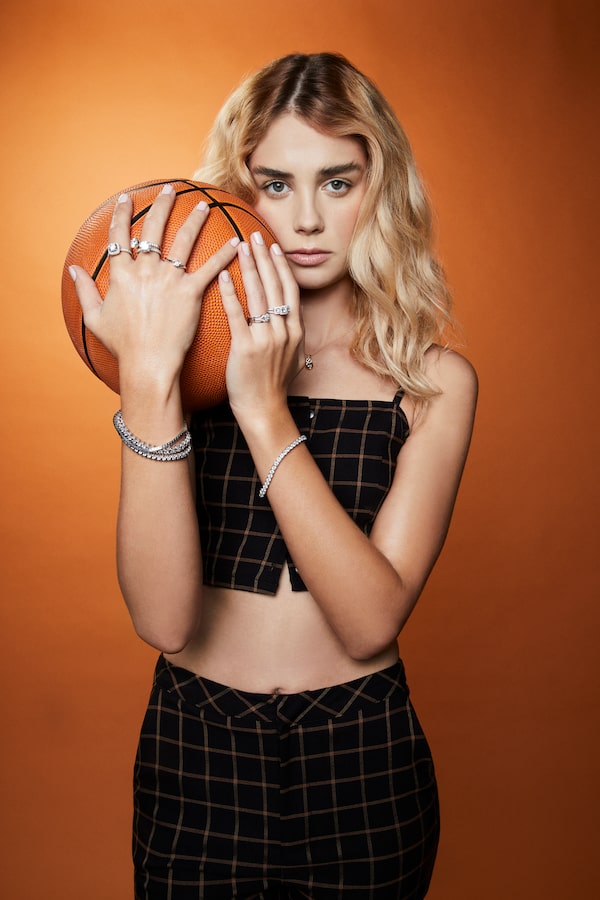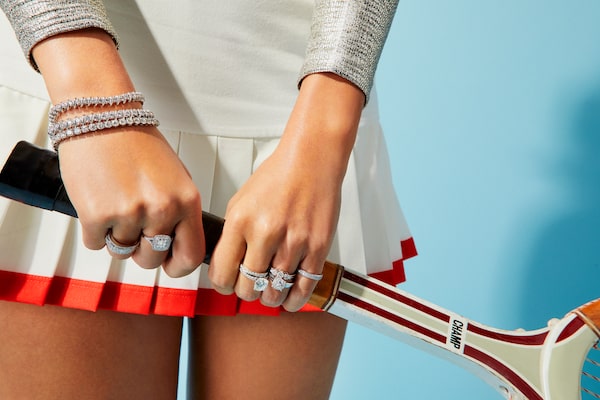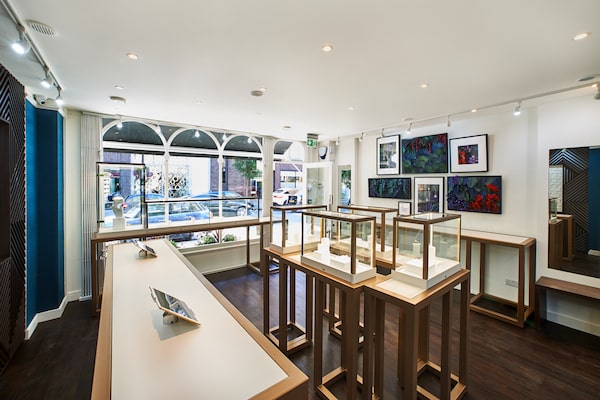
Lark & Berry exclusively sells cultured jewellery at its store in London’s high-end Marylebone neighbourhood.Lark & Berry
In January, when Dame Helen Mirren sat down to chat with the hosts of Good Morning Britain, she was wearing a diamond necklace and earrings that were the essence of the actress herself – classy with just the right touch of pizzazz.
Her stylist Rachel Fanconi had chosen the diamond set carefully. The look she wanted for her Academy Award-winning client was elegant, not flashy, and for the jewels she turned to a tiny company called Lark & Berry, which has an interesting sales pitch. It only sells diamonds made in state-of-the-art laboratories – anything pulled from a mine in say, Botswana, is strictly taboo.
“I love the point of difference that the brand offers,” says Fanconi, whose clients also include Rachel Weisz, Naomi Watts and David Beckham. “Lab grown feels different and fun, and answers a lot of ethical questions.”
Ethics are at the heart of why lab-grown diamonds have steadily increased in popularity over the past year. Millennials love that they are less harmful to the environment and are equally taken with the fact that they cost 30 to 40 per cent less than the mined equivalent. Plus, it’s virtually impossible to tell them apart.
It’s safe to say our grandmothers and mothers would never have dreamed of wearing diamonds that didn’t come from the earth, but this generation doesn’t seem fazed, says Veeral Rathod, chief marketing officer of Spence Diamonds in Vancouver, which sells both lab-grown diamonds (that the company calls Artisan Created Diamonds) and mined ones at its 13 retail stores.

Spence Diamonds sells both lab-grown and mined gems.Spence Diamonds
“The people we see in their 20s and 30s shopping for engagement and bridal rings say value is extremely important to them. They like that they can get a stone that is 30-per-cent larger and they’re certainly more environmentally aware than previous generations.”
He estimates that 80 per cent of their customers now choose the ACD brand over a mined stone. “We don’t believe one diamond is better than the other,” Rathod says. “We simply give them the choice. If you think of a diamond like a plant – one seed grows in the earth and the other is cultivated in a greenhouse. Either way, the plant is the same.”

Around 80 per cent of Spence Diamonds customers choose an 'Artisan Created Diamond' over a traditional mined stone.Spence Diamonds
The U.S. Federal Trade Commission feels the same way. Last summer, the FTC amended its jewellery guidelines to say lab-grown diamonds have the exact same chemical and optical characteristics as a mined diamond. (No such statement has been handed down in Canada).
To create a lab-grown diamond, carbon is placed in a machine where it undergoes rounds of immense heat and pressure. In 10 to 12 weeks, a rough diamond is produced, which is then cut and polished, just like a mined gemstone.
It sounds like a fairly straightforward process, but lab-grown diamond technology has taken years to perfect. For decades, they were used as inexpensive alternatives to mined stones for industrial purposes, but technological advances have steadily enabled scientists to make gemstone-quality grade.
Five years ago, the first plus-one-carat gem-quality lab-created diamond was created. Now plus-10-carat varieties are being produced in even better qualities.
"When I started my company in 2007 they could only grow diamonds to a quarter of a carat,” says Anna-Mieke Anderson, founder of lab-grown diamond purveyor MiaDonna & Co. in Portland, Ore. “They were yellow, had a very limited supply line, and were of much lower quality. Now they’re harder and brighter and far superior.
New York-based mining analyst Paul Zimnisky estimates the lab-grown diamond sector is worth US$1.9-billion. By 2023, he forecasts it will grow to US$5.2-billion and by 2035 to US$14.9-billion. It’s still a tiny fraction of the US$87-billion diamond market worldwide, but is expected to increase as traditional mines deplete and consumers warm up to lab-grown as a viable option.
Last May, De Beers Group, the world’s largest mined diamond player, even got in on the game with the launch of Lightbox, a lab-grown diamond line marketed at the under one carat/under US$800 diamond buyer. De Beers’s theory, which Zimnisky agrees with, is that most of the growth in lab-grown diamonds is going to be in low-cost fashion jewellery. They believe when it comes to that all-important ring that says “I do” for life, most people will choose natural, not man-made.
"I think it’s ridiculous to spend that much money on a diamond that has no intrinsic value,” Zimnisky says. “The high-end diamond market is going to be very small. Most consumers are going to buy a natural earth diamond or a low-price lab-created.”
“Perceptions are changing. It all depends on where your values lie,” says Rita Arva, a 39-year-old sales executive in London, who didn’t give a thought to resale when she and her fiancé purchased her Lark & Berry engagement and wedding rings in January.
“I love my rings and I get so many compliments on them,” she says. “When I tell people they’re lab-grown their initial reaction is, ‘What?’ and then they say, ‘Oh my God, that is just so cool.’”
Leaders in lab-grown gems
MiaDonna
Launched in 2007, the Portland company is a front-runner in cultured diamonds and gems, specializing in handcrafted engagement and bridal jewellery. The company plants one tree through One Tree Planted for every order to offset the carbon emission generated during shipping. miadonna.com
Diamond Foundry
Based in California’s Silicon Valley, it’s one of the biggest producers of synthetic diamonds and uses solar power technology to create its stones. It is backed by Leonardo DiCaprio, the founders of Facebook and Twitter and the founding CEO of eBay. diamondfoundry.com
Spence Diamonds

Spence Diamonds
The 40-year-old company, which is based in Vancouver, launched its Artisan Created Diamonds line in 2017. For each ACD diamond sold Spence donates to Not For Sale, a charity that supports a refugee camp in Uganda and helps those who have been affected by diamond-related human trafficking. spencediamonds.com
Vrai & Oro
It launched in 2014 as a direct-to-consumer fine jewellery line with minimalist pieces. Diamond Foundry acquired it in 2016 and it’s been in expansion mode ever since, recently offering a 3-D online design studio where shoppers can customize a ring from their couches. vraiandoro.com
Lark & Berry

Lark & Barry
The one-year-old company opened the first exclusively cultured jewellery store in London’s high-end Marylebone neighbourhood last summer. Its pieces are popular with several celebrities including Helen Mirren, Jane Seymour and Victoria Secret supermodel Martha Hunt. It also partners with One Tree Planted. larkandberry.com
Live with style. We have a weekly Style newsletter on fashion and design trends, plus shopping tips and inspiration. Sign up today.
 Gayle MacDonald
Gayle MacDonald